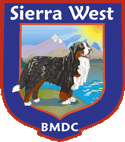By April Rifenburg
Tracking is a sport that Bernese love, for they are using their natural canine instincts in the great outdoors.
People love it as well, especially after they witness their Berner's enjoyment in using this uncanny ability. Tracking eventually involves lots of walking or hiking and is a healthful activity for both ends of the leash. All dogs can track, and Bernese are especially good at it.
The dog is taught to follow a human scent to find a lost “article” of that person, generally a glove or billfold. An AKC Tracking Dog (TD) Title is awarded to dogs that pass at an AKC regulation test.
To get started in tracking, one needs some guidance and information. Working with a friend, a dog club or an instructor is ideal; however it can be done on your own. For the introduction stage, the only equipment necessary is a collar, leash, treats, an article and a couple of stakes. Eventually, a tracking harness is necessary.
“Tracking Fundamentals” is an excellent video by AKC tracking judge Sandy Ganz. You can see what tracking actually looks like. It guides you through training adult dogs and pups, mapping and track laying in a proven five-week program.
Ganz also has co-authored “Tracking Training From the Ground Up,” which is an excellent, easy-to-read guide. These are available through J & J Dog Supplies, as well as an ad in “Front and Finish.”
Other valuable publications are Glen Johnson’s book, “Tracking Dog, Theory & Methods,” and Wentworth Brown's book “Bring Your Nose Over Here.” The Johnson method definitely needs to be diluted for Berners, but is the foundation for reliable tracking. Many other good publications are now available. For those who have internet access, there is a tracking-L and lots of other information. Do a search for “dog tracking” to get started.
Puppies can begin tracking by 3 months of age, allowing for their short attention spans and growing bodies. Two short straight tracks three times a week before a mealtime will teach and motivate until you think your puppy is capable of a more structured schedule. Puppy could even “find” his dinner dish!
I personally start a puppy or dog in tracking by dragging a bone or piece of meat along the “track” during the introduction phase. It really gets them to focus on scenting. I drop this technique after a few times and rely only on the food drops. In early stages I rub the heels of my boots with the food treat. In time the dog will skip most of the food drops in order to find the glove. Beginning stages include “double laying the track” for the first several sessions. The track layer walks out from the start stake the prescribed distance, drops the article with food treat and places a second stake, then turns and walks back along the track to the start hence “double laying.”
“IN THE BEGINNING” TRACKING POINTERS:

|
Make it easy for the dog to be successful in the beginning. Track where you can see the footprints. Train in small increments; short straight tracks gradually getting longer. Use motivators, usually food treats. Wildly praise success.
|

|
Use a 4 to 6-foot leash for early tracking. Guide dog along the track, if necessary. Do not let dog get off the track. Do not let dog become a fringe tracker. For 80 percent of my advanced training, I use a 12-foot nylon leash. After the dog’s tracking ability and style has developed, I eventually use a 30-foot line. If the dog overshoots turns a lot, fringes, or has other problems, I am quick to go back to the 12-foot line.
|

|
After the dog has had a few lessons and you can see the dog is following his nose along the track, be quiet. Let the dog concentrate. Occasional encouragement is okay, but learn to keep your mouth shut. Major praise at glove.
|

|
Tracking can be done five days per week or one day per week, any time of the day, whatever you can fit into your schedule. I have done some at night.
|

|
Teach turns systematically. Do not rush. Use triple laying to help reinforce. I rely heavily on the theory and technique of Week 3 and 4 of Glen Johnson, but generally do only two tracks per outing. I pay attention to wind direction when first introducing turns. I always teach acute turns. Do not allow the dog to run way past the turn in these beginning stages. Whatever you allow a dog to do, you are training a dog to do. If the dog is in the habit of over-running turns, make shorter first legs. Heavily bait and/or triple lay the first 10 steps of the second leg.
|

|
Your Berner puts know-how into his tracking ability file each time you and he track. They always gain experience and learn something positive, even if you think otherwise. |
|
